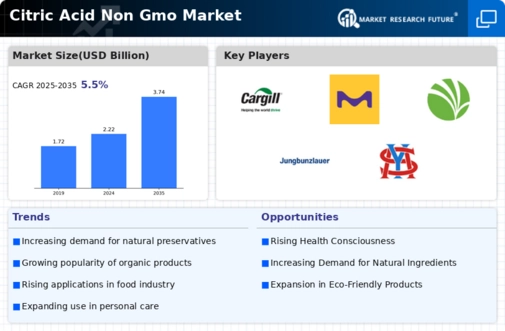Increasing Health Consciousness
The Citric Acid Non-GMO Market is experiencing a notable surge in demand driven by rising health consciousness among consumers. As individuals become more aware of the impact of food additives on their health, there is a marked preference for non-GMO products. This trend is reflected in market data, indicating that the demand for non-GMO citric acid has increased by approximately 15% over the past year. Consumers are actively seeking products that align with their health values, which has prompted manufacturers to adapt their offerings accordingly. This shift not only influences purchasing decisions but also encourages brands to emphasize transparency in their ingredient sourcing. Consequently, the Citric Acid Non Gmo Market is likely to continue expanding as health-conscious consumers prioritize natural and non-GMO ingredients in their diets.
Innovations in Production Techniques
The Citric Acid Non-GMO Market is witnessing advancements in production techniques that enhance the efficiency and sustainability of non-GMO citric acid manufacturing. Innovations such as fermentation technology and bioprocessing are being adopted to produce citric acid more sustainably, reducing environmental impact. Recent studies indicate that these technologies can increase yield by up to 30%, making non-GMO citric acid production more economically viable. As manufacturers embrace these innovations, the Citric Acid Non Gmo Market is likely to see a shift towards more sustainable practices, which not only meet consumer demand but also align with global sustainability goals. This evolution in production methods may further solidify the market position of non-GMO citric acid in various applications.
Expansion of Food and Beverage Sector
The Citric Acid Non-GMO Market is significantly benefiting from the expansion of the food and beverage sector. As the industry grows, there is an increasing incorporation of citric acid as a natural preservative and flavor enhancer in various products. Market analysis suggests that the food and beverage sector is projected to grow at a compound annual growth rate of 4.5% over the next five years, which will likely drive demand for non-GMO citric acid. This growth is attributed to the rising consumer preference for clean-label products, which often feature non-GMO ingredients. As manufacturers strive to meet these evolving consumer demands, the Citric Acid Non Gmo Market is poised for substantial growth, reflecting the broader trends within the food and beverage landscape.
Rising Popularity of Organic Products
The Citric Acid Non-GMO Market is experiencing growth due to the rising popularity of organic products. As consumers increasingly gravitate towards organic food and beverages, the demand for non-GMO citric acid, which is often used in organic formulations, is on the rise. Market data suggests that the organic food sector is expected to grow at a rate of 10% annually, further driving the need for non-GMO ingredients. This trend is indicative of a broader shift towards sustainable and environmentally friendly practices in food production. Consequently, the Citric Acid Non Gmo Market is likely to benefit from this organic movement, as manufacturers seek to align their products with consumer preferences for organic and non-GMO certifications.
Regulatory Support for Non-GMO Products
The Citric Acid Non-GMO Market is positively influenced by increasing regulatory support for non-GMO products. Governments and regulatory bodies are implementing stricter guidelines regarding food labeling and ingredient sourcing, which encourages manufacturers to adopt non-GMO practices. This regulatory environment not only fosters consumer trust but also incentivizes companies to invest in non-GMO citric acid production. Recent data indicates that regions with stringent non-GMO regulations have seen a 20% increase in the market share of non-GMO citric acid. As these regulations continue to evolve, the Citric Acid Non Gmo Market is likely to experience enhanced growth opportunities, as compliance with these standards becomes a competitive advantage for manufacturers.


















Leave a Comment